NVIDIA GeForce GTX 670 Review Feat. EVGA: Bringing GK104 Down To $400
by Ryan Smith on May 10, 2012 9:00 AM ESTAs always, we’re wrapping up our look at a video card’s stock performance with a look at power, temperature, and noise. As GTX 670 is a lower clocked, lower power, harvested version of GK104, it should do even better than GTX 680 here. Remember, the power target for GTX 670 is only 141W.
| GeForce GTX 600 Series Voltages | |||||
| Ref GTX 670 Boost Load | EVGA GTX 670SC Boost Load | Ref GTX 680 Boost Load | Ref GTX 670 Idle | ||
| 1.175v | 1.162v | 1.175v | 0.987v | ||
Stopping to take a quick look at voltages, we find that NVIDIA hasn’t really adjusted the voltages of GTX 670 compared to GTX 680. Because GTX 670 has a lower maximum boost bin than GTX 680 it ramps up to 1.175v a bit sooner, but otherwise it’s still covering the same range of voltages as opposed to having a lower max voltage to further improve the power consumption. EVGA however does just that, topping out at 1.162v. They’ll need all the power savings they can get since power consumption is inversely proportional to performance under NVIDIA’s power target system.
On that note before we jump into our graphs we wanted to try something new: a look at the average core clockspeed during our benchmarks. Because of GPU boost the boost clock alone doesn’t give us the whole picture – particularly when also taking a look at factory overclocked cards – we’ve recorded the clockspeed of our GPU during each of our benchmarks when running them at 2560x1600 and computed the average clockspeed over the duration of the benchmark.
| GeForce GTX 670 Average Clockspeeds | ||||
| GTX 670 | EVGA GTX 670SC | |||
| Max Boost Clock | 1084MHz | 1188MHz | ||
| Crysis | 1057MHz | 1079MHz | ||
| Metro | 1042MHz | 1066MHz | ||
| DiRT 3 | 1037MHz | 1062MHz | ||
| Shogun 2 | 1064MHz | 1105MHz | ||
| Batman | 1042MHz | 1075 MHz | ||
| Portal 2 | 988MHz | 1034MHz | ||
| Battlefield 3 | 1055MHz | 1080MHz | ||
| Starcraft II | 1084MHz | 1129MHz | ||
| Skyrim | 1084MHz | 1113MHz | ||
| Civilization V | 1038MHz | 1073MHz | ||
| OCCT | 953MHz | 980MHz | ||
In spite of the GTX 670’s boost clock of only 980MHz, we see that it spends almost its entire time above that, and indeed spends its whole time above the base clock. As far as games go, with the exception of Portal 2 it’s always in the mid-1000s, whereas the GTX 680 was only a bit higher at the high 1000s. This is a big part of why the GTX 670 has performed so well in our tests: it may be rated lower, but in fact it can reach clockspeeds very close to the GTX 680.
At the same time this is why we see the EVGA GTX 670 Superclocked struggle to separate itself from the reference GTX 670, in spite of a 6%+ factory overclock. Too much of the time it’s simply not boosting much higher than the reference GTX 670, which limits the performance gains. With GPU Boost in effect this means there are a range of cards and we could be looking at a particularly good reference GTX 680, but whether that’s the case or not the end result is that EVGA’s card can’t do too much amidst the 141W power target limit.
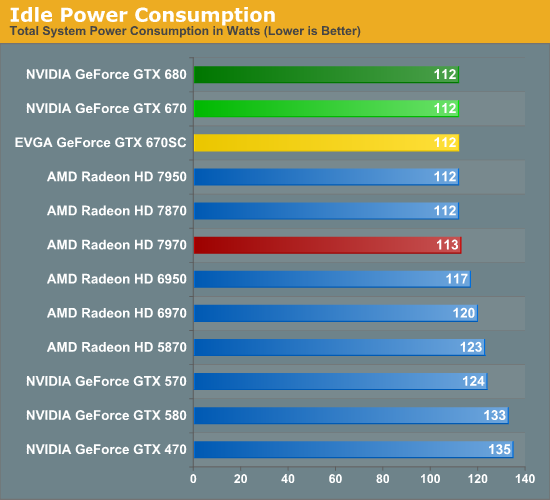
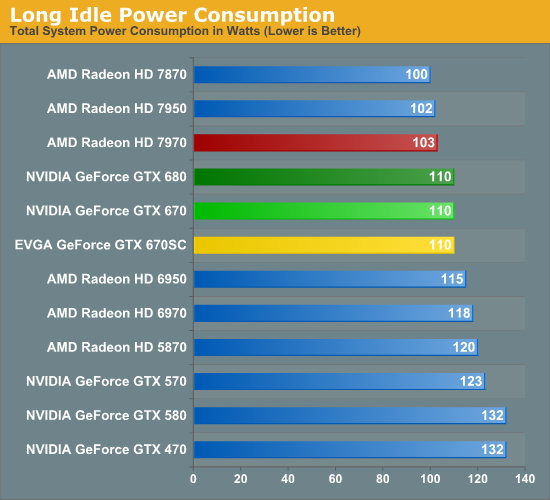
Starting with idle power, there aren’t any major surprised compared to the GTX 680. NVIDIA and AMD have both done such a good job managing their idle power consumption that even with the disabled SMX there’s no measurable difference between video cards. GTX 680 and GTX 670 effectively have the same idle and long idle power consumption.
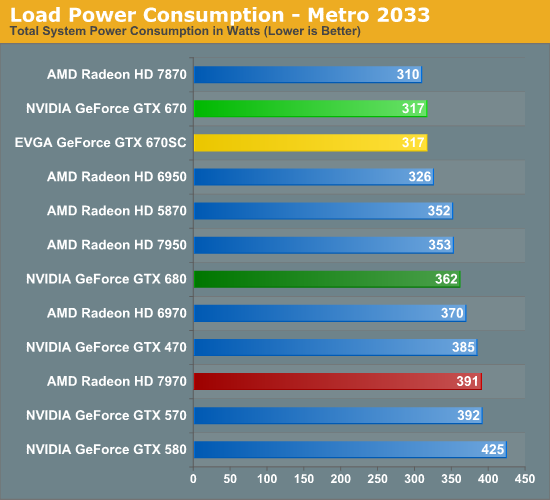
Moving on to load power consumption we can immediately see the GTX 670’s lower power target come into play. At 317W from the wall it’s 45W less than the GTX 680 for roughly 90% of the gaming performance, and this is in fact is lower power consumption than anything except the Radeon HD 7870. Even the GTX 560 Ti (which isn’t in this chart) is higher at 333W, reflecting the fact that GK104 is the true successor to GF114, and which would make GTX 670 the successor to GTX 560 from a design perspective.
Of course this also means that GTX 670 does very well for itself compared to AMD’s cards. We saw GTX 670 slightly outperform 7950 in Metro and here we see it drawing 36W less at the wall at the same time. Or compared to the 7970, 7970 can outperform GTX 670 by about 10%, but we’re drawing 74W more at the wall as a result.
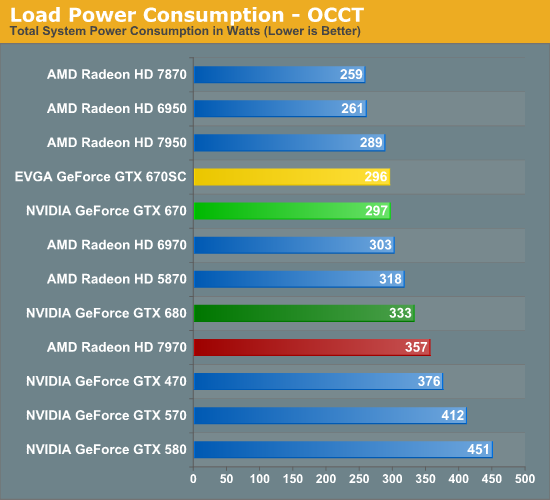
Relative power consumption shifts slightly under OCCT, but the story is otherwise similar. It’s not immediately clear why GTX 670’s power consumption is slightly higher than 7950 even after what we saw with Metro (PowerTune should be capping at 200W), but at least in this test the GTX 670 does end up doing a bit worse. On the other hand it’s still 60W less than the 7970.
Otherwise if we compare the GTX 670 to the GTX 680 we see that the GTX 680 ends up drawing 36W more at the wall, only a bit less than the difference we saw under Metro and quite close to what we’d expect based on the cards’ specifications.
On a related note, pay close attention to NVIDIA’s power target system in action here. In spite of the fact that the GTX 670SC is a binned part running at a lower voltage and higher clockspeeds, it’s drawing 1W less than the reference GTX 670. It would appear that NVIDIA has very good control over their power consumption overall, even if they can only adjust clocks for it a few times per second.
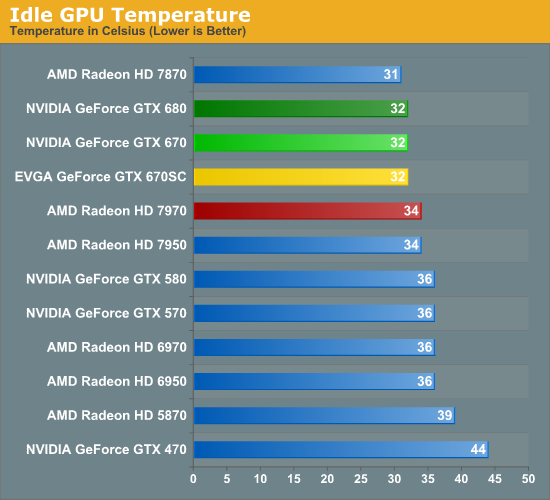
Seeing as how NVIDIA is using roughly the same cooler design with GTX 670 as they are with GTX 680 and they have the same idle power consumption, it should come as no surprise that temperatures are so similar. 32C is among the lowest of the temperatures we’ll see for a blower unless it’s running fast & loud.
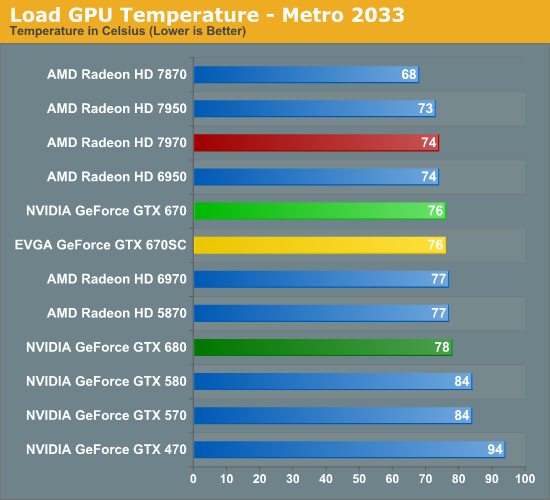
Thanks to the lower power consumption of the GTX 670 temperatures have gone down as well. 76C is still 2C warmer than the Radeon HD 7900 series due to AMD’s more aggressive cooler but it’s 2C cooler than the GTX 680. The thermal threshold for GK104 is 98C, which means there’s still over 20C of thermal headroom to play with here.

OCCT pushes temperatures up some, but not by much thanks to NVIDIA’s power target system. Since the GTX 680 tied the 7970 at 79C here, this means the GTX 670 is 2-3C cooler than both the GTX 680 and the 7970, and 0-1C warmer than the 7950.
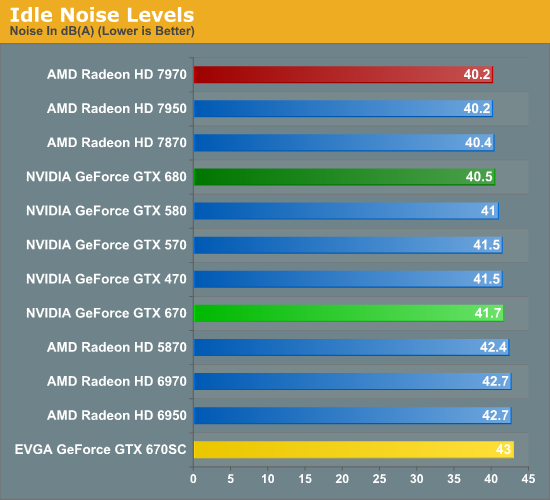
Unfortunately the impressiveness of the GTX 670 begins to wane some here at noise. NVIDIA tells us that the GTX 670 uses the same fan as the GTX 680 but this seems questionable. 41.7dB is not significantly louder than the GTX 680’s 40.5dB, but there’s a definite difference in pitch compared to the GTX 680. The GTX 670 seems to have a low pitch hum/grind to it that GTX 680 didn’t have.
Meanwhile EVGA’s card fares the worst here, at the precipice of falling out of the quiet zone. Since it’s using what’s fundamentally the same fan and cooler as the reference card, the only practical explanation is that EVGA’s smaller diameter fan intake has a negative impact on fan noise.
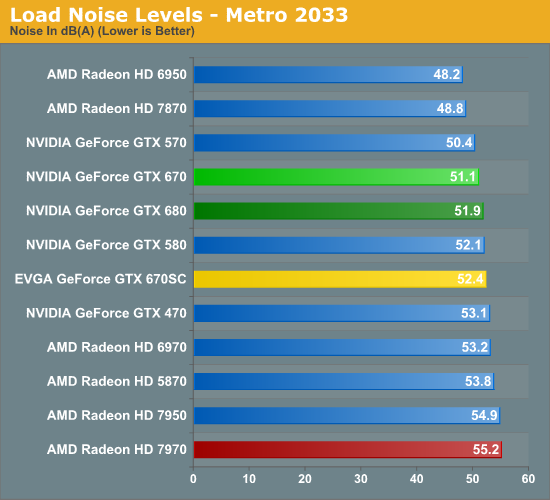
Finally, when looking at load noise we see that the GTX 670 doesn’t fare significantly better or worse than the GTX 680 here. At 0.8dB quieter than the GTX 680 the GTX 670 is a smidge quieter, but it’s nothing that’s particularly appreciable. Perhaps the more important fact is that this is 3.8dB quieter than the 7950 and 4.1dB quieter than the 7970, making the GTX 670 notable quieter than either 7900 series card. In practice the only place the GTX 670 loses is oddly enough to the GTX 570. The GTX 570 was 0.7dB quieter than the GTX 670 despite the former’s much higher power consumption. NVIDIA did let the GTX 570 get hotter than the GTX 670 so it looks like the GTX 670’s fan curve is a bit more aggressive than the GTX 570’s.
As for the EVGA GTX 670 Superclocked we’re seeing the same thing that we saw at idle: it’s just a bit louder than the reference GTX 670. This is in spite of the fact that the GTX 670SC’s fan actually went to the same speed as the reference GTX 670’s fan in this test.
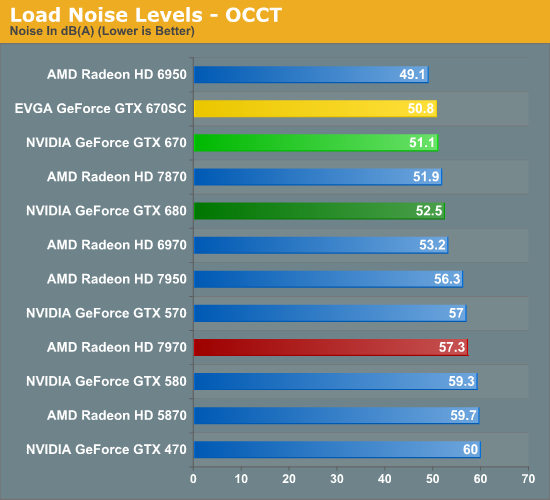
NVIDIA’s power target once more makes itself known here, thanks to which power consumption and thereby heat generation increases very little compared to what we saw under Metro. This widens the gap between the GTX 670 and 7900 series, which is now at 5.2dB and 6.2dB compared to the 7950 and 7970 respectively. Or compared to NVIDIA cards this is 1.4dB quieter than the GTX 680 and nearly 6dB quieter than the unthrottled GTX 570.
Meanwhile there’s something very interesting going on with the GTX 670SC that’s a wider reflection of the GTX 670’s reference fan. The fan speed went up but objective noise (A-weighted) went down. Why? That low-pitch hum we mentioned diminishes with a higher fan speed, and as a result the fan gets quieter once it passes a certain threshold. Subjectively we agree with our sound meter: the GTX 670SC sounds quieter here than it does as the lower fan speed it uses for cooling during Metro. We haven’t experienced anything like this with the GTX 680, which makes us further doubt that the fans are identical between the GTX 680 and GTX 670. Close no doubt, but not the same.
Wrapping things up this entire scenario is very similar to how we saw the launch of the GTX 680 play out. NVIDIA has a strong performing part with less noise and less power consumption than either its 500 series predecessors or AMD’s closest competition. This in turn was a big part of what made the GTX 680 so easy to recommend, as better performance with less noise is exactly the kind of direction we like to see video cards move in.










414 Comments
View All Comments
eachus - Friday, May 11, 2012 - link
"I would like to see a 7970OC comparison? I was trying to find a 680 but gave up and got an 7970oc for $499 it's running at 1025Mhz and should be faster than a 680."No need really--unless you want to use the latest and greatest benchmarks in an on-line pissing contest. Let's face it. ANY high-end card, including now what AMD calls mid-range (the 7800 series) will run a 1920x1200 display with no trouble. Upgrade to three displays (5760x1200) or one 2560x1600 display, and now the high-end cards make sense. But keep track of the evolving drivers...the original 7970 benchmarks are now dead letters given the 12.4 drivers. Fixing lots of little gotchas in the drivers means that now you don't need two cards to drive a three screen display. This is true of both nVidia and AMD. (Compare the benchmarks here with the launch benchmarks for the 680. The 7970 wins several benchmarks now, which will last until nVidia has some non-launch drivers. Since you are getting more performance than you originally paid for, just sit back and enjoy it.)
Oh, and one other point which is starting to become an issue: 3d graphics. When I find a 3d display that doesn't give me headaches with a few hours use, I'll buy one. Right now though, it is already clear that 120 fps displays will be needed for that, and AMD has been considering 90+ fps out of the ROPs as sufficient--at least with 2560x1600, non-Crossfire. :-(
CeriseCogburn - Friday, May 11, 2012 - link
Well eachus amd fanboy friend, instead of calling him and idiot owner of the 7970 in a useless pissing contest, why don't you just tell him the truth ?The 7970 LOSES @ 1,025 core clock to the stock 680.
+
And yes, amd sucks when it comes to 3d gaming, while nVidia is the king and has the market absolutely cornered.
CeriseCogburn - Friday, May 11, 2012 - link
Here's a comparison dunce.http://hexus.net/tech/reviews/graphics/37209-gefor...
The amd card loses with just it overclocked.
Enjoy that amd fail.
Chris Simmo - Thursday, May 10, 2012 - link
Excellent review. Excellent card! One thing I didn't see was image quality. Both in game and video/HT capability. I know its not a common thing amoungst gamers and self builders, but we do complete systems and always found that AMD does a better job with video than NVIDIA. Most noticable are old TV show rips or youtube videos. Do you have any opinion? Just want to know if its a good allrounder or only good at games.CeriseCogburn - Friday, May 11, 2012 - link
Well, you must have enjoyed the years long amd youtube issues with constantly crashing adobe flash, having to turn off the HW acell, etc.I sure hope your customers didn't mind.
Chris Simmo - Friday, May 11, 2012 - link
Actually we have had few reports, and they have been pretty even on both sides, but the only time I have had to turn off hardware acceleration is with TMT5 SIMHD engine with any HD7000 card, and I have seen the flash problems you are talking about, but strangly only on notebooks, not desktops. I do believe a fix is in the works for TMT though. I really hope so. Anyway, I am not looking at it from a fanboy point of view. I will give my customers what they want, but will push the most capable product for their application and for a long while now this has generally been AMD graphics with Intel CPU's. This has come up well as we have had an incredibly low failure rate.Support is important and in the last 6 months I have worked with both ASUS and AMD support to correct issues in motherboards and driver bugs, and as long as they get fixed I am happy, providing it’s not a really big issue to start with.
I’m sure you have worked with 1200 graphics cards in the last 4 years and know exactly what you are talking about, and offer support to match the warranty, which in our case is 2 years.
I am excited about the 600 series though, and will look to stock the GTX670 when the prices settle.
CeriseCogburn - Saturday, May 12, 2012 - link
Hundreds of graphics cards but not 1200 graphics cards, so yes I do know what I'm talking about, and I'm not stuck in a corporate environment where information and standard responses are a required line to be towed, so it's likely my experience this past year is actually far wider than yours.In any case, you allude to "pretty even on both sides" with flash player problems, but before you claimed youtube was great with amd, or at least claimed some sort of superior image quality - and mentioned old movie clips, but by your own comparison you must be servicing nVidia cards as well, or perhaps you are not, and the choice was made and now...
So to me that appears to be your corporate environment talking as you'll go with whatever your masters say is happening, and it is said to be better then, by default necessity - as whomever decides in the power structure will in effect be demanding employees tow that line, it is after all, foolish to do otherwise, especially in a forum where you could be easily discovered doing so.
I frankly find your surprise lack of knowledge with flash player issues disturbing, but attribute it to the call center corporate support model.
Anyway go ahead with your issue, and find the answer you need. I think you should do well with whatever it is you need for answer, and think no doubt that has already been determined.
Chris Simmo - Sunday, May 13, 2012 - link
You assume a lot. There isn't much of your argument there that actually holds any truth, and you are the foolish one to assume otherwise. To me it appears you are just looking for a fight. No better than a common troll. And as a result I won't bother with a rebuttal or correcting any of your assumptions.Ryan Smith - Friday, May 11, 2012 - link
Hi Chris;Since image quality is almost entirely a function of architectural improvements as opposed to the individual SKUs, we don't do a major IQ writeup for every card. For Kepler in game image quality hasn't changed (NVIDIA hasn't changed any of the fundamental algorithms). As for HT/video, we're hoping to have something up soon once we can secure a more HTPC-suitable GK107 card.
-Thanks
Ryan Smith
Chris Simmo - Friday, May 11, 2012 - link
Thanks Ryan. Yeah, I knew its an architectural thing. I build some very high powered HTPC as gaming systems and since this card will no doubt end up shipping with smaller coolers, it seems like a great card to put in a gaming HTPC. Looking forward to the HTPC review though.